
A | B | C | D | E | F | G | H | CH | I | J | K | L | M | N | O | P | Q | R | S | T | U | V | W | X | Y | Z | 0 | 1 | 2 | 3 | 4 | 5 | 6 | 7 | 8 | 9
| History of Russia |
|---|
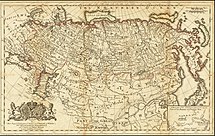 |
|
|



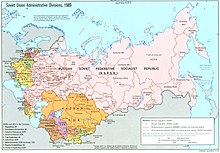
The history of Russia begins with the histories of the East Slavs.[1][2] The traditional start date of specifically Russian history is the establishment of the Rus' state in the north in 862, ruled by Varangians.[3][4] In 882, Prince Oleg of Novgorod seized Kiev, uniting the northern and southern lands of the Eastern Slavs under one authority, moving the governance center to Kiev by the end of the 10th century, and maintaining northern and southern parts with significant autonomy from each other. The state adopted Christianity from the Byzantine Empire in 988, beginning the synthesis of Byzantine and Slavic cultures that defined Russian culture for the next millennium. Kievan Rus' ultimately disintegrated as a state due to the Mongol invasions in 1237–1240. After the 13th century, Moscow emerged as a significant political and cultural force, driving the unification of Russian territories. By the end of the 15th century, many of the petty principalities around Moscow had been united with the Grand Duchy of Moscow, which took full control of its own sovereignty under Ivan the Great.
Ivan the Terrible transformed the Grand Duchy into the Tsardom of Russia in 1547. However, the death of Ivan's son Feodor I without issue in 1598 created a succession crisis and led Russia into a period of chaos and civil war known as the Time of Troubles, ending with the coronation of Michael Romanov as the first Tsar of the Romanov dynasty in 1613. During the rest of the seventeenth century, Russia completed the exploration and conquest of Siberia, claiming lands as far as the Pacific Ocean by the end of the century. Domestically, Russia faced numerous uprisings of the various ethnic groups under their control, as exemplified by the Cossack leader Stenka Razin, who led a revolt in 1670–1671. In 1721, in the wake of the Great Northern War, Tsar Peter the Great renamed the state as the Russian Empire; he is also noted for establishing St. Petersburg as the new capital of his Empire, and for his introducing Western European culture to Russia. In 1762, Russia came under the control of Catherine the Great, who continued the westernizing policies of Peter the Great, and ushered in the era of the Russian Enlightenment. Catherine's grandson, Alexander I, repulsed an invasion by the French Emperor Napoleon, leading Russia into the status of one of the great powers.
Peasant revolts intensified during the nineteenth century, culminating with Alexander II abolishing Russian serfdom in 1861. In the following decades, reform efforts such as the Stolypin reforms of 1906–1914, the constitution of 1906, and the State Duma (1906–1917) attempted to open and liberalize the economy and political system, but the emperors refused to relinquish autocratic rule and resisted sharing their power. A combination of economic breakdown, mismanagement over Russia's involvement in World War I, and discontent with the autocratic system of government triggered the Russian Revolution in 1917. The end of the monarchy initially brought into office a coalition of liberals and moderate socialists, but their failed policies led to the October Revolution. In 1922, Soviet Russia, along with the Ukrainian SSR, Byelorussian SSR, and Transcaucasian SFSR signed the Treaty on the Creation of the USSR, officially merging all four republics to form the Soviet Union as a single state. Between 1922 and 1991 the history of Russia essentially became the history of the Soviet Union.[opinion] During this period, the Soviet Union was one of the victors in World War II after recovering from a surprise invasion in 1941 by Nazi Germany and its collaborators, which had previously signed a non-aggression pact with the Soviet Union. The Soviet Union's network of satellite states in Eastern Europe, which were brought into its sphere of influence in the closing stages of World War II, helped the country become a superpower competing with fellow superpower the United States and other Western countries in the Cold War.
By the mid-1980s, with the weaknesses of Soviet economic and political structures becoming acute, Mikhail Gorbachev embarked on major reforms, which eventually led to the weakening of the communist party and dissolution of the Soviet Union, leaving Russia again on its own and marking the start of the history of post-Soviet Russia. The Russian Soviet Federative Socialist Republic renamed itself as the Russian Federation and became the primary successor state to the Soviet Union.[5] Russia retained its nuclear arsenal but lost its superpower status. Scrapping the central planning and state-ownership of property of the Soviet era in the 1990s, new leaders, led by President Vladimir Putin, took political and economic power after 2000 and engaged in an assertive foreign policy. Coupled with economic growth, Russia has since regained significant global status as a world power. Russia's 2014 annexation of the Crimean Peninsula led to economic sanctions imposed by the United States and the European Union. Russia's 2022 invasion of Ukraine led to significantly expanded sanctions. Under Putin's leadership, corruption in Russia is rated as the worst in Europe, and Russia's human rights situation has been increasingly criticized by international observers.
Prehistory
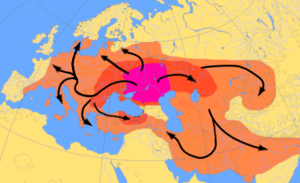
The first human settlement on the territory of Russia dates back to the Oldowan period in the early Lower Paleolithic. About 2 million years ago, representatives of Homo erectus migrated from Western Asia to the North Caucasus (archaeological site of Kermek on the Taman Peninsula[6]). At Bogatyri/Sinyaya balka, in a skull of Elasmotherium caucasicum, which lived 1.5–1.2 million years ago, a stone tool was found.[7] 1.5-million-year-old Oldowan flint tools have been discovered in the Dagestan Akusha region of the north Caucasus, demonstrating the presence of early humans in the territory of present-day Russia.[8]
Fossils of Denisovans in Russia date to about 110,000 years ago.[9] DNA from a bone fragment found in Denisova Cave, belonging to a female who died about 90,000 years ago, shows that she was a hybrid of a Neanderthal mother and a Denisovan father.[10] Russia was also home to some of the last surviving Neanderthals - the partial skeleton of a Neanderthal infant in Mezmaiskaya cave in Adygea showed a carbon-dated age of only 45,000 years.[11] In 2008, Russian archaeologists from the Institute of Archaeology and Ethnology of Novosibirsk, working at the site of Denisova Cave in the Altai Mountains of Siberia, uncovered a 40,000-year-old small bone fragment from the fifth finger of a juvenile hominin, which DNA analysis revealed to be a previously unknown species of human, which was named the Denisova hominin.[12]
The first trace of Homo sapiens on the large expanse of Russian territory dates back to 45,000 years, in central Siberia (Ust'-Ishim man). The discovery of some of the earliest evidence for the presence of anatomically modern humans found anywhere in Europe was reported in 2007 from the Kostenki archaeological site near the Don River in Russia (dated to at least 40,000 years ago[13]) and at Sungir (34,600 years ago). Humans reached Arctic Russia (Mamontovaya Kurya) by 40,000 years ago.
During the prehistoric eras the vast steppes of Southern Russia were home to tribes of nomadic pastoralists. (In classical antiquity, the Pontic Steppe was known as "Scythia".[14]) Remnants of these long-gone steppe cultures were discovered in the course of the 20th century in such places as Ipatovo,[14] Sintashta,[15] Arkaim,[16] and Pazyryk.[17]
Antiquity
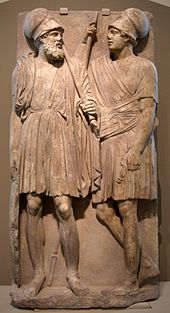
In the later part of the 8th century BCE, Greek merchants brought classical civilization to the trade emporiums in Tanais and Phanagoria.[18] Gelonus was described by Herodotus as a huge (Europe's biggest) earth- and wood-fortified grad inhabited around 500 BC by Heloni and Budini. In 513 BC, the king of the Achaemenid Empire, Darius I, would launch a military campaign around the Black Sea into Scythia, modern-day Ukraine, eventually reaching the Tanais river (now known as the Don).
Greeks, mostly from the city-state of Miletus, would colonize large parts of modern-day Crimea and the Sea of Azov during the seventh and sixth centuries BC, eventually unifying into the Bosporan Kingdom by 480 BC, and would be incorporated into the large Kingdom of Pontus in 107 BC. The Kingdom would eventually be conquered by the Roman Republic, and the Bosporan Kingdom would become a client state of the Roman Empire. At about the 2nd century AD Goths migrated to the Black Sea, and in the 3rd and 4th centuries AD, a semi-legendary Gothic kingdom of Oium existed in Southern Russia until it was overrun by Huns. Between the 3rd and 6th centuries AD, the Bosporan Kingdom was also overwhelmed by successive waves of nomadic invasions,[19] led by warlike tribes which would often move on to Europe, as was the case with the Huns and Turkish Avars.
In the second millennium BC, the territories between the Kama and the Irtysh Rivers were the home of a Proto-Uralic-speaking population that had contacts with Proto-Indo-European speakers from the south. The woodland population is the ancestor of the modern Ugrian inhabitants of Trans-Uralia. Other researchers say that the Khanty people originated in the south Ural steppe and moved northwards into their current location about 500 AD.
A Turkic people, the Khazars, ruled the lower Volga basin steppes between the Caspian and Black Seas through to the 8th century.[20] Noted for their laws, tolerance, and cosmopolitanism,[21] the Khazars were the main commercial link between the Baltic and the Muslim Abbasid empire centered in Baghdad.[22] They were important allies of the Eastern Roman Empire,[23] and waged a series of successful wars against the Arab Caliphates.[20][24] In the 8th century, the Khazars embraced Judaism.[24]
Early history
Early Slavs
Some of the ancestors of the modern Russians were the Slavic tribes, whose original home is thought by some scholars to have been the Pripet Marshes.[25] The Early East Slavs gradually settled Western Russia in two waves: one moving from Kiev (present-day Ukraine) towards present-day Suzdal and Murom and another from Polotsk (present-day Belarus) towards Novgorod and Rostov.[26]
From the 7th century onwards, East Slavs constituted the bulk of the population in Western Russia[26] and slowly conquered and assimilated the native Finnic and Baltic tribes, such as the Merya,[27] the Muromians,[28] and the Meshchera.[29]
Kievan Rus' (862–1240)

Scandinavian Norsemen, known as Vikings in Western Europe and Varangians[30] in the East, combined piracy and trade throughout Northern Europe. In the mid-9th century, they began to venture along the waterways from the eastern Baltic to the Black and Caspian Seas.[31] According to the legendary Calling of the Varangians, recorded in several Rus' chronicles such as the Novgorod First Chronicle and Primary Chronicle, the Varangians Rurik, Sineus and Truvor were invited in the 860s to restore order in three towns – either Novgorod (most texts) or Staraya Ladoga (Hypatian Codex); Beloozero; and Izborsk (most texts) or "Slovensk" (Pskov Third Chronicle), respectively.[32][30][33][34] Their successors allegedly moved south and extended their authority to Kiev,[35] which had been previously dominated by the Khazars.[36]
Thus, the first East Slavic state, Rus', emerged in the 9th century along the Dnieper River valley.[34] A coordinated group of princely states with a common interest in maintaining trade along the river routes, Kievan Rus' controlled the trade route for furs, wax, and slaves between Scandinavia and the Byzantine Empire along the Volkhov and Dnieper Rivers.[34]
By the end of the 10th century, the minority Norse military aristocracy had merged with the native Slavic population,[37] which also absorbed Greek Christian influences in the course of the multiple campaigns to loot Tsargrad, or Constantinople.[38] One such campaign claimed the life of the foremost Slavic druzhina leader, Svyatoslav I, who was renowned for having crushed the power of the Khazars on the Volga.[39]
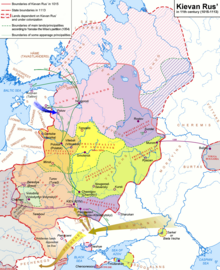
Kievan Rus' is important for its introduction of a Slavic variant of the Eastern Orthodox religion,[34] dramatically deepening a synthesis of Byzantine and Slavic cultures that defined Russian culture for the next thousand years. The region adopted Christianity in 988 by the official act of public baptism of Kiev inhabitants by Prince Vladimir I.[40] Some years later the first code of laws, Russkaya Pravda, was introduced by Yaroslav the Wise.[41] From the onset, the Kievan princes followed the Byzantine example and kept the Church dependent on them.[42]
By the 11th century, particularly during the reign of Yaroslav the Wise, Kievan Rus' displayed an economy and achievements in architecture and literature superior to those that then existed in the western part of the continent.[43] Compared with the languages of European Christendom, the Russian language was little influenced by the Greek and Latin of early Christian writings.[34] This was because Church Slavonic was used directly in liturgy instead.[44] A nomadic Turkic people, the Kipchaks (also known as the Cumans), replaced the earlier Pechenegs as the dominant force in the south steppe regions neighbouring to Rus' at the end of the 11th century and founded a nomadic state in the steppes along the Black Sea (Desht-e-Kipchak). Repelling their regular attacks, especially in Kiev, was a heavy burden for the southern areas of Rus'. The nomadic incursions caused a massive influx of Slavs to the safer, heavily forested regions of the north, particularly to the area known as Zalesye.[citation needed]
Kievan Rus' ultimately disintegrated as a state because of in-fighting between members of the princely family that ruled it collectively. Kiev's dominance waned, to the benefit of Vladimir-Suzdal in the north-east, Novgorod in the north, and Halych-Volhynia in the south-west. Conquest by the Mongol Golden Horde in the 13th century was the final blow. Kiev was destroyed.[45] Halych-Volhynia would eventually be absorbed into the Polish–Lithuanian Commonwealth,[34] while the Mongol-dominated Vladimir-Suzdal and independent Novgorod Republic, two regions on the periphery of Kiev, would establish the basis for the modern Russian nation.[34]
Mongol invasion and vassalage (1223–1480)

The invading Mongols accelerated the fragmentation of the Rus'. In 1223, the disunited southern princes faced a Mongol raiding party at the Kalka River and were soundly defeated.[46] In 1237–1238 the Mongols burnt down the city of Vladimir (4 February 1238)[47] and other major cities of northeast Russia, routed the Russians at the Sit' River,[48] and then moved west into Poland and Hungary. By then they had conquered most of the Russian principalities.[49] Only the Novgorod Republic escaped occupation and continued to flourish in the orbit of the Hanseatic League.[50]
Zdroj:https://en.wikipedia.org?pojem=History_of_Russia
Text je dostupný za podmienok Creative Commons Attribution/Share-Alike License 3.0 Unported; prípadne za ďalších podmienok. Podrobnejšie informácie nájdete na stránke Podmienky použitia.
Antropológia
Aplikované vedy
Bibliometria
Dejiny vedy
Encyklopédie
Filozofia vedy
Forenzné vedy
Humanitné vedy
Knižničná veda
Kryogenika
Kryptológia
Kulturológia
Literárna veda
Medzidisciplinárne oblasti
Metódy kvantitatívnej analýzy
Metavedy
Metodika
Text je dostupný za podmienok Creative
Commons Attribution/Share-Alike License 3.0 Unported; prípadne za ďalších
podmienok.
Podrobnejšie informácie nájdete na stránke Podmienky
použitia.
www.astronomia.sk | www.biologia.sk | www.botanika.sk | www.dejiny.sk | www.economy.sk | www.elektrotechnika.sk | www.estetika.sk | www.farmakologia.sk | www.filozofia.sk | Fyzika | www.futurologia.sk | www.genetika.sk | www.chemia.sk | www.lingvistika.sk | www.politologia.sk | www.psychologia.sk | www.sexuologia.sk | www.sociologia.sk | www.veda.sk I www.zoologia.sk
